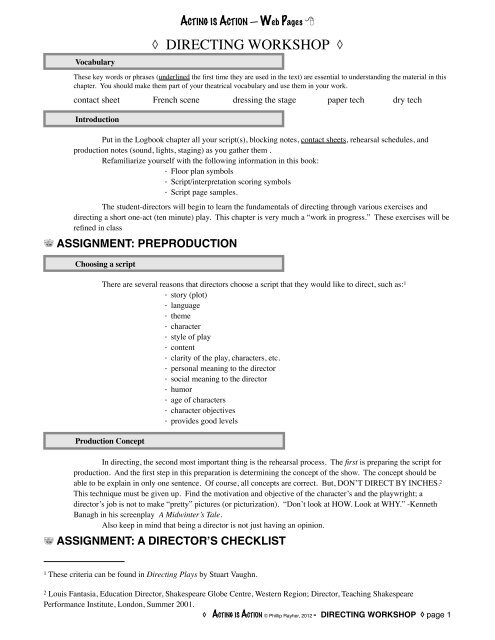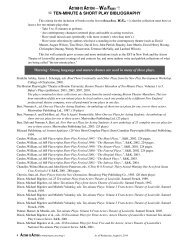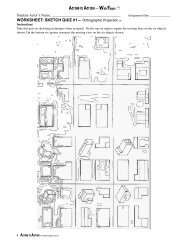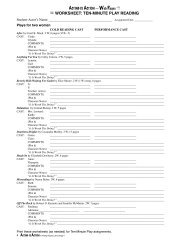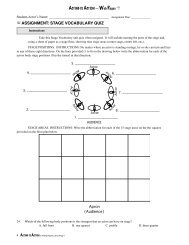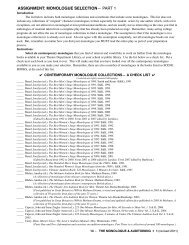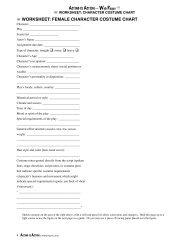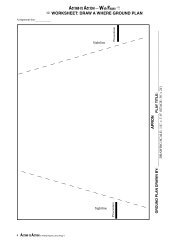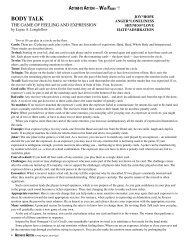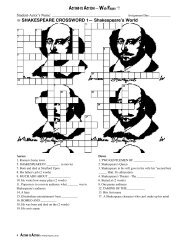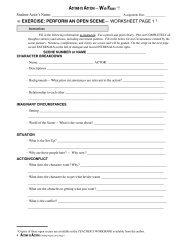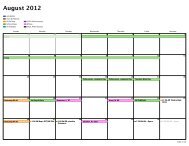DIRECTING WORKSHOP CHAPTER - the SOTA Theatre Department!
DIRECTING WORKSHOP CHAPTER - the SOTA Theatre Department!
DIRECTING WORKSHOP CHAPTER - the SOTA Theatre Department!
- No tags were found...
Create successful ePaper yourself
Turn your PDF publications into a flip-book with our unique Google optimized e-Paper software.
ACTING IS ACTION — Web Pages Vocabulary◊ <strong>DIRECTING</strong> <strong>WORKSHOP</strong> ◊These key words or phrases (underlined <strong>the</strong> first time <strong>the</strong>y are used in <strong>the</strong> text) are essential to understanding <strong>the</strong> material in thischapter. You should make <strong>the</strong>m part of your <strong>the</strong>atrical vocabulary and use <strong>the</strong>m in your work.contact sheet French scene dressing <strong>the</strong> stage paper tech dry techIntroductionPut in <strong>the</strong> Logbook chapter all your script(s), blocking notes, contact sheets, rehearsal schedules, andproduction notes (sound, lights, staging) as you ga<strong>the</strong>r <strong>the</strong>m .Refamiliarize yourself with <strong>the</strong> following information in this book:· Floor plan symbols· Script/interpretation scoring symbols· Script page samples.The student-directors will begin to learn <strong>the</strong> fundamentals of directing through various exercises anddirecting a short one-act (ten minute) play. This chapter is very much a “work in progress.” These exercises will berefined in classASSIGNMENT: PREPRODUCTIONChoosing a scriptThere are several reasons that directors choose a script that <strong>the</strong>y would like to direct, such as: 1· story (plot)· language· <strong>the</strong>me· character· style of play· content· clarity of <strong>the</strong> play, characters, etc.· personal meaning to <strong>the</strong> director· social meaning to <strong>the</strong> director· humor· age of characters· character objectives· provides good levelsProduction ConceptIn directing, <strong>the</strong> second most important thing is <strong>the</strong> rehearsal process. The first is preparing <strong>the</strong> script forproduction. And <strong>the</strong> first step in this preparation is determining <strong>the</strong> concept of <strong>the</strong> show. The concept should beable to be explain in only one sentence. Of course, all concepts are correct. But, DON’T DIRECT BY INCHES. 2This technique must be given up. Find <strong>the</strong> motivation and objective of <strong>the</strong> character’s and <strong>the</strong> playwright; adirector’s job is not to make “pretty” pictures (or picturization). “Don’t look at HOW. Look at WHY.” -KennethBanagh in his screenplay A Midwinter’s Tale.Also keep in mind that being a director is not just having an opinion.ASSIGNMENT: A DIRECTORʼS CHECKLIST1 These criteria can be found in Directing Plays by Stuart Vaughn.2 Louis Fantasia, Education Director, Shakespeare Globe Centre, Western Region; Director, Teaching ShakespearePerformance Institute, London, Summer 2001.◊ ACTING IS ACTION © Phillip Rayher, 2012 - <strong>DIRECTING</strong> <strong>WORKSHOP</strong> ◊ page 1
ACTING IS ACTION — Web Pages First ReadingRead through in one sitting, with intermission (if indicated), as if you were an audience member. FIRSTIMPRESSIONS? Do you see <strong>the</strong> characters in <strong>the</strong> setting in your mind? Do you see <strong>the</strong> characters move in yourmind?Second Reading“Read with a pencil.” Divide <strong>the</strong> script into workable sections and “French” scenes. A “French” scene is asection of a scene or act which begins and ends with <strong>the</strong> entrance or exit of each named character and <strong>the</strong> number ofcharacters in that section is constant. A “French” scene is not marked in a script. A “French” scene is so namedbecause <strong>the</strong> entrance or exit of a character designated a new scene in classic French drama.Since <strong>the</strong> entrances or exits change <strong>the</strong> dynamics of <strong>the</strong> scene, it is sometimes useful to break up <strong>the</strong> actionfor rehearsal purposes, especially blocking rehearsals, into “French” scenes.Create a list <strong>the</strong> characters; write a brief description for each. What does each character want?Sample Character ListNancy: His wife of 2 years -- in her 20s -- assertive and fun-loving -- in some ways, very head-strong.Third ReadingDick: Linda: Young executive type -- constantly leaves messages with his office -- all his deals are failures.A true romantic -- does not like Dick’s business view of life -- like Allan, a neurotic -- works as a model-- is a bit dingy.Read with a pencil and paper, take notes. Following is a checklist of elements to consider.▫ Style: Realism, Selective Realism, Stylization, Symbolism, Formalism, etc.▫ Establish mood and atmosphere.▫ Reveal character.▫ Planning <strong>the</strong> action.▫ Plan <strong>the</strong> Blocking▫ Blocking Creates Clarity▫ Blocking Creates Focus· Focus intrinsic to <strong>the</strong> script· Focus intrinsic to <strong>the</strong> staging▫ To Preblock or Not to Preblock? 3▫ Pre-rehearsal blocking Methods· Blocking with chess board and chess men· Blocking on <strong>the</strong> model· Blocking using floor plans. Photocopy floor plan, do blocking patterns. usecolored markers to differentiate characters. Use proper stage symbols.KEY: COLOR CHARACTER▫ Stage Composition / Balance▫ Planes and levels▫ Movement, emphasis, balance▫ Variety, placement, focus▫ Check body positions -- open, closed upstaged, covered▫ Dressing <strong>the</strong> stage· groupings· isolations· establishes character relationships▫ SET FLOOR PLAN▫ Sketch possible floor plans. Establishes entrances and exits, sight lines, movement and trafficpatterns (lines and patterns of movement).▫ Set, furniture, props placement3 see p. 145, Frerer◊ ACTING IS ACTION © Phillip Rayher, 2012 - <strong>DIRECTING</strong> <strong>WORKSHOP</strong> ◊ page 2
ACTING IS ACTION — Web Pages ▫ Architectural logic▫ Axis of set▫ Symmetrical balance, Asymmetrical balance▫ PREPARE PROMPT BOOKIllustrations: The sample layouts of a page of a typical Prompt Book.Illustration: Following <strong>the</strong> Actor’s Line of Sight. Actor’s eye contact (focus) leads to <strong>the</strong> “strongest”character. O<strong>the</strong>r things being equal, Americans eyes tend to begin scanning <strong>the</strong> stage from <strong>the</strong> “top left-handcorner” or stage right.Stage Right LOOKS Stronger. Alexander Dean, in his legendary text Fundamentals of Directing, arguesthat in general, and o<strong>the</strong>r things being equal, stage right is stronger than stage left. Why? The obvious reason isthat in most of <strong>the</strong> Western World we are naturally inclined to look from left to right in reading and that we carrythis to all phases of observation. Asians read from right to left and, interestingly enough, in <strong>the</strong>ir <strong>the</strong>atre <strong>the</strong> moreimportant position is stage left. For example, stage left in <strong>the</strong> Chinese <strong>Theatre</strong> is where chairs are placed for <strong>the</strong>royalty and o<strong>the</strong>r important people. In a scene between a hero and villain, <strong>the</strong> Chinese convention is to always have<strong>the</strong> hero on <strong>the</strong> right and <strong>the</strong> villain on <strong>the</strong> left.◊ ACTING IS ACTION © Phillip Rayher, 2012 - <strong>DIRECTING</strong> <strong>WORKSHOP</strong> ◊ page 3
ACTING IS ACTION — Web Pages ◊ ACTING IS ACTION © Phillip Rayher, 2012 - <strong>DIRECTING</strong> <strong>WORKSHOP</strong> ◊ page 4
ACTING IS ACTION — Web Pages WORKSHEET: A DIRECTORʼS SCHEDULE REHEARSALS (Including: Initial Rehearsal Calender, Final Rehearsal Calender)Establish <strong>the</strong> ratio of rehearsal time. How much time do you have? How much do you have to do?READ THROUGH(S) Date: _______ Time: ________BLOCKING REHEARSALSNotes on running an effective rehearsal— go by beats first, <strong>the</strong>n progress to scenes and acts.Begin and end all rehearsals on time. Only <strong>the</strong> characters that appear in <strong>the</strong> scenes to be workedfor a certain period of time need to be <strong>the</strong>re.EVERYONE MUST TAKE DOWN BLOCKING NOTES!DEVELOPING REHEARSALSOFF-BOOK REHEARSALSActors Off Script Date: _______________POLISHING REHEARSALSRUN THROUGH REHEARSALSWORKING (REHEARSAL) PROPSWORKING (REHEARSAL) COSTUMES PAPER TECH DRY TECH TECHNICAL REHEARSALS DRESS REHEARSALS (first, second) PREVIEWS Date: _________ Time: __________Date: _________ Time: __________Date: _________ Time: __________Date: _________ Time: __________Date: _________ Time: __________◊ ACTING IS ACTION © Phillip Rayher, 2012 - <strong>DIRECTING</strong> <strong>WORKSHOP</strong> ◊ page 5
EXERCISE: SCRIPT ANALYSIS— THE CONCEPTIntroductionACTING IS ACTION — Web Pages correct.What is <strong>the</strong> concept of <strong>the</strong> show? It should be able to be explain in just one sentence. All concepts areInstructionsThe student-directors will demonstrate <strong>the</strong>ir ability to develop and understand a “concept” of a script bybreaking down an assigned script (of 2-3 page). Using a single script with which all student-directors are familiar,list all of <strong>the</strong> class’s concept suggestions on <strong>the</strong> board and have <strong>the</strong> student-directors defend <strong>the</strong>m, keep <strong>the</strong> ones thathave a good basis.EXERCISE: SCRIPT CONCEPT— VISUALIZATIONSIntroductionThis process of “illustrating” <strong>the</strong> production concept using o<strong>the</strong>r art forms (poems, photographs, art work,music, architecture, dance, etc.) is called “Viz.” It aids in <strong>the</strong> interpretation of a script. It must always be done in adifferent medium than <strong>the</strong> original.You will be shown examples of production visualization concepts (slides, poems, pictures of a variety ofsubjects, music, architecture). The instructor will prepare a short Viz slide presentation to be shown to <strong>the</strong> class thatgoes along with a piece of music or a reading of some sort. All <strong>the</strong> lights will be off and <strong>the</strong> music playing as youenter <strong>the</strong> room.ExampleReading <strong>the</strong> poem by Walt Whitman called “I Hear American Singing,” and show pictures of a variety ofAmerican citizens. Play Bach's Brandenburg Concertos and show slides of large, magnificent buildings from allover <strong>the</strong> world.InstructionsYou will <strong>the</strong>n demonstrate your understanding of visualizations by providing a “Viz” for a 2-3 page scene.The student-directors will also be assigned <strong>the</strong> job of providing a Viz that will accompany <strong>the</strong>ir final project scene.EXERCISE: CASTINGInstructionsThe class will be split into groups. Each group will be given a short scene which <strong>the</strong>y will cast withfamous actors. Each group will stand and explain why <strong>the</strong>y cast <strong>the</strong> scene <strong>the</strong> way <strong>the</strong>y did.Criteria will be discussed: Character vs. personality actors, ability to carry a play, looks, intelligence, vocalclarity, etc.EXERCISE: SCRIPT ANALYSIS— SCRIPT BEATSInstructionsTaking your knowledge of “beats” of a script, French scenes, etc., go to <strong>the</strong> above script and break it intobeats with <strong>the</strong> entire class.EXERCISE: SCRIPT ANALYSIS— OBJECTIVESInstructions◊ ACTING IS ACTION © Phillip Rayher, 2012 - <strong>DIRECTING</strong> <strong>WORKSHOP</strong> ◊ page 6
What are <strong>the</strong> Super Objectives of each character? Use <strong>the</strong> script from <strong>the</strong> day before and apply objectivesand tactics to <strong>the</strong> already broken-up beats.EXERCISE: STORYTELLING THROUGH MOVEMENTInstructionsThe Instructor will provide several pre-written short situations with a clear and definite beginning andending. The class will be split into groups by assigning a number to each student as <strong>the</strong>y enter <strong>the</strong> room. The shortpre-written situation will be given each group. The student-directors will demonstrate <strong>the</strong>ir understanding of one of<strong>the</strong> common blocking principles, movement, by blocking this “silent” 2-3 page scene. Act out <strong>the</strong> situations withoutwords, using movement only.What more could each have done to more clearly tell <strong>the</strong> story? Do it again incorporating what wasdiscussed.ExampleYou go to <strong>the</strong> grocery store to buy a pop but don't have enough money to get it so you leave.EXERCISE: BLOCKING— THE BODYInstructionsStudent-directors will demonstrate a knowledge of <strong>the</strong>ir bodies by playing, “Move it like this.” Studentdirectorswill name as many movable body parts <strong>the</strong>y can think of. A volunteer at <strong>the</strong> board will write <strong>the</strong>se down.Can anyone think of any o<strong>the</strong>rs that are not on <strong>the</strong> list? A one-minute monologue will be passed out. You are topick at least 10 different movable parts and use <strong>the</strong>m during <strong>the</strong> course of <strong>the</strong> monologue. You will have time to gothrough <strong>the</strong> monologue and make choices. You will perform your monologue and discuss what is observed.EXERCISE: BLOCKING A MONOLOGUE— MOVEMENTInstructionsStudent-directors will demonstrate <strong>the</strong> knowledge of body movement by performing a monologue. We willdiscuss and brainstorm what strong body positions and strong body movements might be.Draw a stage floor plan on <strong>the</strong> board. Student-directors will give <strong>the</strong>ir ideas on where <strong>the</strong> strongest placeson stage are (mark <strong>the</strong>se with an ‘x’) and <strong>the</strong>n <strong>the</strong> weakest (mark <strong>the</strong>se with an ‘o’). Discuss <strong>the</strong>ir reasons for <strong>the</strong>irchoices.Discuss <strong>the</strong> strongest entrance choices and <strong>the</strong> effects <strong>the</strong>y have on <strong>the</strong> audience. Example: movementcoming from up center going straight towards <strong>the</strong> audience creates dramatic question - Strongest movement, orentrance from stage left creates conflict vs. stage right which feels natural or non-confrontational.A volunteers will come to <strong>the</strong> front of <strong>the</strong> space and demonstrate <strong>the</strong>se positions and movements. Studentdirectorswill add more movements as <strong>the</strong>y think of <strong>the</strong>m (keeping <strong>the</strong>m appropriate).Student-directors get into groups of three. Using <strong>the</strong> monologue from previous exercise you will givemovement to <strong>the</strong> monologue and <strong>the</strong>n have one from each group perform it. Discuss what <strong>the</strong>y observed. What isstrong and weak? Discuss <strong>the</strong> stronger positions vs. <strong>the</strong> weaker. What positions are natural vs. unnatural?EXERCISE: BLOCKING & THE SETTING— FURNITUREInstructionsACTING IS ACTION — Web Pages All of <strong>the</strong> rehearsal furniture (chairs, stools, benches, cubes, small tables, o<strong>the</strong>r rehearsal furniture) isspread out all over <strong>the</strong> front of <strong>the</strong> room. Two volunteers come up and make a set to use for a scene. They are nottold what <strong>the</strong> scene is or where it might take place, be creative.Discuss what <strong>the</strong> student-directors did with <strong>the</strong> pieces. What did <strong>the</strong>y like, dislike?Repeat <strong>the</strong> exercise with two different volunteers, this time tell <strong>the</strong>m where <strong>the</strong> scene takes place and whathappens.◊ ACTING IS ACTION © Phillip Rayher, 2012 - <strong>DIRECTING</strong> <strong>WORKSHOP</strong> ◊ page 7
Discuss what happened differently <strong>the</strong> second time when <strong>the</strong> student-directors knew more about <strong>the</strong> scene.What did <strong>the</strong>y observe, what is working? What isn't?Discuss <strong>the</strong> influence <strong>the</strong> set has on <strong>the</strong> blocking.EXERCISE: BLOCKING & SETTING— LEVELSInstructionsACTING IS ACTION — Web Pages Illustration:Contrasts in LevelStudent-directors will demonstrate <strong>the</strong> ability to understand levels in blocking a scene. Discuss <strong>the</strong> need fordifferent levels in blocking.Part 1: Student-directors come to <strong>the</strong> front of <strong>the</strong> room and try to create as many different levels as <strong>the</strong>ycan on a set already created, using chairs, stools, benches, blocks (cubes), small tables, o<strong>the</strong>r rehearsal furniture.They can not move any of <strong>the</strong> set pieces.Part 2: A volunteer comes up and shows <strong>the</strong> class <strong>the</strong> three strongest body positions on stage and <strong>the</strong>ndiscusses how <strong>the</strong>ir relative strength changes with <strong>the</strong> incorporation of levels.Part 3: Student-directors pair off and block <strong>the</strong> scene selected using as many different levels as <strong>the</strong>y can (atleast one per beat), using chairs, stools, benches, blocks (cubes), small tables, o<strong>the</strong>r rehearsal furniture. You haveten minutes to practice <strong>the</strong> scene. Each team perform <strong>the</strong>ir scene. Discuss <strong>the</strong> strengths and weaknesses.Illustration: Variety of Level Without PlatformsEXERCISE: BLOCKING— PROPSInstructionsThe student-directors will demonstrate <strong>the</strong>ir ability to use stage props and an improvised set effectively byincorporating props and set pieces into a short scene or ten-minute play.Various props (fruits and vegetables of various sizes and shapes, pieces of paper, a container, two bedsheets, a hat, a piece of rope) and set pieces (chairs, tables, cubes, et cetera) will be randomly handed out to eachstudent-director/cast. You will have five minutes to improvise a two to five minute scene using all of <strong>the</strong> materials.First, brain-storm -- “How many different things could <strong>the</strong>y use one of <strong>the</strong> sheets for?”You are all going to perform short scenes for <strong>the</strong> entire class and you must each somehow incorporate <strong>the</strong>materials you are given into <strong>the</strong> scene.· You can not eat or destroy <strong>the</strong> fruit or vegetable.· It can be anything except for what it is in real life. In o<strong>the</strong>r words, you can't use anorange as an orange.· You must incorporate at least two of <strong>the</strong> fruits or vegetables into <strong>the</strong>ir scene.Evaluate <strong>the</strong> student-directors. What did <strong>the</strong>y find hard about it? Did it make some parts of <strong>the</strong>ir sceneeasier? Were <strong>the</strong>y able to incorporate o<strong>the</strong>r characteristics to ano<strong>the</strong>r object? (Such as making a banana a phone.)Ask <strong>the</strong>m how this could be helpful in acting. How can props both help and hinder a scene? Discuss briefly.EXERCISE: BLOCKING— NATURAL VS. UNNATURAL◊ ACTING IS ACTION © Phillip Rayher, 2012 - <strong>DIRECTING</strong> <strong>WORKSHOP</strong> ◊ page 8
ACTING IS ACTION — Web Pages InstructionsStudent-directors will demonstrate an understanding of internalizing movement and making it natural byperforming a short scene.What makes movement natural? Brainstorm and write down all <strong>the</strong> ideas on <strong>the</strong> board. Bring <strong>the</strong> focusdown to <strong>the</strong> objectives being physicalized.Student-directors get into pairs. Each team as it comes up, draws a situation out of <strong>the</strong> hat (situations forimprov, short two person scene). Each team is to do an improv of <strong>the</strong> situation striving for very realistic, naturalmovement. O<strong>the</strong>r student-directors should be taking notes on what <strong>the</strong>y observe. Discuss internalizing movementsthat are given and finding inner motivation for <strong>the</strong>ir character to perform <strong>the</strong> given blocking.Extended exerciseç Give everyone <strong>the</strong> same script and <strong>the</strong> same blocking and have <strong>the</strong> groups come up and perform. Ask <strong>the</strong>student-directors what <strong>the</strong>y observed. What did <strong>the</strong>y like, not like, and why?EXERCISE: STAGE PICTURESInstructionsUsing an assigned scene or section of a scene <strong>the</strong> student-directors will demonstrate <strong>the</strong>ir knowledge ofcreating and presenting “stage pictures.”Step 1: Look at a number of examples of “stage pictures” in classical art works, such as: Michelangelo’sThe Last Supper, Edward Hopper’s Nighthawks, et cetera. Especially <strong>the</strong> works of Bruegel “<strong>the</strong> Elder,” JanVermeer, Dürer, Hogarth, Goya, Daumier, Marsh and Hopper. You should look for what are called ‘Genre pictures.’These are pictures in which <strong>the</strong> painters deliberately cultivated a certain branch or kind of subject, particularlyscenes from daily life.Have a group of students recreate <strong>the</strong>se “stage pictures” for <strong>the</strong> class. There is extensive information on <strong>the</strong>types of pictures to use for this exercise in <strong>the</strong> exercise “Playing Pictures” in The Contentless Scene chapter.Step 2: Using an assigned scene create and present a series of “stage pictures” in <strong>the</strong> scene. Establish a“stage picture” every 20 lines or so, and create <strong>the</strong> blocking that moves <strong>the</strong> characters out of and in to <strong>the</strong>se pictures.Edward Hopper (American, 1882-1967) People in <strong>the</strong> sun◊ ACTING IS ACTION © Phillip Rayher, 2012 - <strong>DIRECTING</strong> <strong>WORKSHOP</strong> ◊ page 9
ACTING IS ACTION — Web Pages Honorè Daumier (French 1808-1879) The Country Visitor’s PleasureEXERCISE: <strong>DIRECTING</strong> THE “OPEN” SCENEIntroductionStudent-directors will demonstrate <strong>the</strong> understanding of directing and blocking fundamentals by drawing arandom scene and blocking it for a performance.InstructionsFill in <strong>the</strong> following information on <strong>the</strong> <strong>DIRECTING</strong> THE OPEN SCENE WORKSHEET as instructed.Use a pencil, print clearly. Record EXTERNALS on left of dialogue, record INTERNALS on right. Plot out allthought (subtext) and action, including movement patterns, COMPLETELY. See <strong>the</strong> following pages for a sampledescription of this scene.Given Circumstance (created by <strong>the</strong> director):ONE: TWO: ONE: TWO: ONE: TWO: ONE: TWO: ONE: TWO: Objectives: CHARACTER ONE: ACTOR: _________________________Objectives: CHARACTER TWO: ACTOR: _________________________Oh.Yes.Why are you doing this?It's <strong>the</strong> best thing.You can't mean it.No, I'm serious.Please.What?What does this mean?Nothing.EXTERNALS INTERNALS(including Beats) Thought Patterns (subtext)◊ ACTING IS ACTION © Phillip Rayher, 2012 - <strong>DIRECTING</strong> <strong>WORKSHOP</strong> ◊ page 10
ACTING IS ACTION — Web Pages ONE: TWO: ONE: TWO: ONE: TWO: ONE: TWO: ONE: TWO: Listen.No.So different.Not really.Oh.You're good.Forget it.What.Go on.I will.A sample description of this sceneSCENE TITLE: Time to Let Go. The CHARACTERS: One is Wife. Two is Husband. The couple lost <strong>the</strong>ironly child before <strong>the</strong> baby reached <strong>the</strong> age of three. Since <strong>the</strong> couple had only one child late in <strong>the</strong>ir marriage, <strong>the</strong>ywere unable to have any more. The tragic death occurred about six months ago. The wife has often been foundsobbing hysterically over <strong>the</strong> child's box of toys. The day has come when <strong>the</strong> husband is determined to get rid of <strong>the</strong>toys, because of <strong>the</strong> way <strong>the</strong>y continue to haunt him and his wife. 4# ACTIVITY SUBTEXTI She enters bedroom to find something to distract herself2 She finds and opens hook to grab first available diversion3 She sits on bed to calm herself4 She pages through book to occupy her mind5 She hears noise: starts; recovers to suppress her fears6 She crosses to door to somehow stop what she expects7 He enters with basket to make her understand his plan8 She says, "Oh." to get him to stop9 He says. "Yes." to make her understand he will not back down10 She touches <strong>the</strong> toys to somehow touch her child as well11 She asks, "Why are you doing this?" to cause him to change his mind12 He says. "It's <strong>the</strong> best thing." to persuade her that he is doing this because <strong>the</strong>y need it13 She takes <strong>the</strong> basket to stay close to <strong>the</strong> toys14 She says, "You can't mean it." to intimidate him15 She kneels. puts toys on <strong>the</strong> floor to keep <strong>the</strong>m near her16 He moves to put a hand on her shoulder to comfort her17 He says. "No, I'm serious." to get her to comprehend that he will not be dissuaded18 She picks up a doll from <strong>the</strong> basket to cling to it19 She says. "Please." to get him to back off20 He says, "What?" to force her to at least speak of it21 She holds <strong>the</strong> doll like a baby to bring back <strong>the</strong> feeling of comforting22 She says, "What does this mean? to arouse his grief23 He says, "Nothing." to maintain control24 He turns away to find a less devastating sight25 She picks out music box to find a more powerful weapon26 She plays it to pull him into her perspective27 She says, "Listen." to remind him of better times28 He says, "No." to fight <strong>the</strong> music's effect29 He crosses to o<strong>the</strong>r side of room to regain firmness and purpose30 She rises and faces him to confront him combatively31 She says, "So different." to accuse him of insensitivity32 He turns to face her to stop <strong>the</strong> charge33 He says, "Not really." to accept his own vulnerability34 She says, "Oh." to acknowledge his feelings35 She goes to him to make peace36 She embraces him to apologize and comfort37 They hold each o<strong>the</strong>r to gain strength4 This particular open scene was created by Wandalie Henshaw who has <strong>the</strong> distinction of being <strong>the</strong> inventor of <strong>the</strong> “openscene.” She developed this exercise in <strong>the</strong> late ‘60s. See Wandalie Henshaw. “The ‘Open Scene’ as a Directing Exercise.”Educational <strong>Theatre</strong> Journal 21, (October 1969): 275-284.◊ ACTING IS ACTION © Phillip Rayher, 2012 - <strong>DIRECTING</strong> <strong>WORKSHOP</strong> ◊ page 11
38 He looks at her to check if she is ready39 He holds onto her, says,"You're good." to assure her that she has <strong>the</strong> strength to give <strong>the</strong> toys up40 She slowly returns <strong>the</strong> toys to say good-bye to <strong>the</strong> child41 She stand up, looks away to end her attachment42 She says to herself, "Forget it." to discipline herself43 She picks up basket to test herself44 She hands basket to him to free herself from any temptation to change her mind45 He says, "What?" to get a verbal commitment from her46 She quietly says, "Go on." to encourage him to do it quickly before he weakens47 He says, "I will" to accept <strong>the</strong> offer firmly and close <strong>the</strong> discussion48 He exits with toys to accomplish his task49 She listens to music box to linger an instant longer in <strong>the</strong> pastfading as it gets far<strong>the</strong>r away50 She sits on <strong>the</strong> bed to support herself51 She lies down and curls up on <strong>the</strong> bed to comfort herself and help her resolveWORKSHEET: <strong>DIRECTING</strong> THE “OPEN” SCENEInstructionsACTING IS ACTION — Web Pages Fill in <strong>the</strong> following information as instructed. Use a pencil, print clearly.On <strong>the</strong> script on <strong>the</strong> next page record EXTERNALS on left of dialogue, record INTERNALS on right. Plotout all thought (subtext) and action, including movement patterns, COMPLETELY.For a sample description of this scene see <strong>the</strong> Directing Chapter.Given Circumstance/Plot (created by <strong>the</strong> director): _______________________________________________________________________________________________________________________________________________________________________________________________________________________________________________________________________________________________________________________________________________________________________________________________________________________________________________________________________________________________________________________________________________________________________________________________________________________________________________________________________________________________________________________________________________________________________________________________________________________________________________________________________________________________________________________________________________________________________________________________________________________________________Objectives: CHARACTER ONE: ACTOR: _________________________________________________________________________________________________________________________________________________________________________________________________________________________________________________________________________________________________________________________________________________________________________________________________________________________________________________________________________________________________________________________________________________________________________________________________________________________________________________________________________________________◊ ACTING IS ACTION © Phillip Rayher, 2012 - <strong>DIRECTING</strong> <strong>WORKSHOP</strong> ◊ page 12
ACTING IS ACTION — Web Pages Objectives: CHARACTER TWO: ACTOR: _________________________________________________________________________________________________________________________________________________________________________________________________________________________________________________________________________________________________________________________________________________________________________________________________________________________________________________________________________________________________________________________________________________________________________________________________________________________________________________________________________________________ALWAYS MAKE SPECIFIC CHOICES!ONE: TWO: ONE: TWO: ONE: TWO: ONE: TWO: ONE: TWO: ONE: TWO: ONE: TWO: ONE: TWO: ONE: TWO: ONE: EXTERNALS INTERNALS(including Beats) Thought Patterns (subtext)Oh.Yes.Why are you doing this?It's <strong>the</strong> best thing.You can't mean it.No, I'm serious.Please.What?What does this mean?Nothing.Listen.No.So different.Not really.Oh.You're good.Forget it.What.Go on.◊ ACTING IS ACTION © Phillip Rayher, 2012 - <strong>DIRECTING</strong> <strong>WORKSHOP</strong> ◊ page 13
ACTING IS ACTION — Web Pages TWO: I will.◊ ACTING IS ACTION © Phillip Rayher, 2012 - <strong>DIRECTING</strong> <strong>WORKSHOP</strong> ◊ page 14
Objective6.small cube (chair, end table, et cetera)7.sofa or bed or ?8.small cube (television or ottoman or planter or ?)9.window or fireplace or built in bookcase or ?Working with a single given ground plan is at first helpful because it limits <strong>the</strong> choices and keeps <strong>the</strong> workfrom becoming a ground plan exercise. Also <strong>the</strong> provided ground plan puts workshop directors literally on acommon ground. Seeing how different directors solve <strong>the</strong> justifying problems in exactly <strong>the</strong> same space also bringsan excitement to <strong>the</strong> workshop. Regardless of whatever else is brought to <strong>the</strong>se basic exercises, <strong>the</strong> overall intenthas to remain <strong>the</strong> same: all must be fully justified within a realistic context.Critique2.Was <strong>the</strong> situation (<strong>the</strong> who, <strong>the</strong> what, and <strong>the</strong> where) well communicated?3.(To <strong>the</strong> director) Which of <strong>the</strong> four scenes was <strong>the</strong> hardest to motivate?4.Was everything fully justified, or were <strong>the</strong>re some motivational problems and/or stretches?5.Was <strong>the</strong>re a balance between <strong>the</strong> verbal and visual elements of <strong>the</strong> scene? Or did one tend to dominate <strong>the</strong>o<strong>the</strong>r?6.Favorite moment? Least favorite moment?EXERCISE: JUSTIFIED MOVEMENT— PICK UP SIXInstructionsTeams of three -- one director and two actors. A bag of “cards” is prepared from <strong>the</strong> blocking diagramsprovided in <strong>the</strong> Worksheet Chapter. Each actor draws six cards (i.e., a total of 12 cards will be used). The challengeis to create characters and a situation that fully integrate <strong>the</strong> selected movements. Two important ground rules are:1) Each character must do all of <strong>the</strong> selected movements, exactly as depicted, but <strong>the</strong>y may be done in any order,and2) if needed, up to 6 transitional movements per actor may be created.Suggestions· Run through <strong>the</strong> movements, searching for movements that flow toge<strong>the</strong>r with o<strong>the</strong>r movements. One or more of<strong>the</strong>se links may provide <strong>the</strong> “seed” for your basic situation. With <strong>the</strong> situation in mind, it will be fairly easy tocreate whatever transitional movements are needed to connect all <strong>the</strong> movements fully.·· Ano<strong>the</strong>r approach is to create <strong>the</strong> specific order of movements before deciding upon a situation. Begin by findingall <strong>the</strong> possible links and creating whatever transitory movements are needed to use all of <strong>the</strong> selected movements.Then run through <strong>the</strong> movements several times until someone gets an interesting idea to try. If <strong>the</strong> idea seems to“catch,” continue to refine it, improvising dialogue suitable for <strong>the</strong> situation.·· Remember, this is not a playwriting exercise. Strive to create simple lines which can easily be memorized byyour actors.The Ground PlanACTING IS ACTION — Web Pages The setting is an interior with two entrances. The logic of <strong>the</strong> space and <strong>the</strong> specific designation of <strong>the</strong> setpieces depend upon your situation. For instance, #10 can ei<strong>the</strong>r be a sofa, desk, a trunk, a shelf, or something else.Possibilities for each of <strong>the</strong> given set pieces are offered below -- feel free to make up your own.◊ ACTING IS ACTION © Phillip Rayher, 2012 - <strong>DIRECTING</strong> <strong>WORKSHOP</strong> ◊ page 16
ACTING IS ACTION — Web Pages CritiqueSet piece # Description1 & 2 Maybe a small chair and desk, or a stool and shelf, or ?3-7 Table with four chairs or an exercise trampoline with four pillows, or ?8 Rectangular set piece (maybe a cabinet, bar, gun case, trunk), or ?9 Cube or chair (maybe a television, swivel chair, bed table), or ?10 Large platform (maybe a bed, desk, trunk, low table, rowing machine), or ?11 Small cube or chair (maybe an end table, a wastebasket, a CD player stand), or ?12 Vertical unit (maybe a cabinet, gun case, large screen TV), or ?13 Circular stand (maybe a pedestal for a statue, plant, bottled water), or ?14 Vertical unit (maybe a fireplace, window, cabinet, closet), or ?To <strong>the</strong> director1.Did you end up creating <strong>the</strong> flow of movements first, and <strong>the</strong>n figuring out <strong>the</strong> situation, or did aparticular movement provide <strong>the</strong> inspiration for <strong>the</strong> idea? In o<strong>the</strong>r words, what was <strong>the</strong> major stimulus inbringing about <strong>the</strong> idea for <strong>the</strong> scene? Did it come from a specific movement, or from a discovered “link”between two movements? Or did <strong>the</strong> idea come after <strong>the</strong> series of movements was completed?2.Were <strong>the</strong>re any specific movements that were especially difficult to motivate? Did you ultimatelyovercome <strong>the</strong> difficulty?3.How helpful were <strong>the</strong> team members in solving this exercise?To <strong>the</strong> rest of <strong>the</strong> workshop4.Was <strong>the</strong> who, what, and where clearly established?5.Were <strong>the</strong>re any interesting psychological areas created?6.Was <strong>the</strong> overall situation interesting? Would <strong>the</strong> scene stand on its own. meaning if someone didn't know<strong>the</strong> exercise, would this still be considered effective <strong>the</strong>atre? Was <strong>the</strong>re a definite beginning, middle, andend?7.Were <strong>the</strong>re any effective visual pauses?8.Did <strong>the</strong> dialogue seem to fit <strong>the</strong> movement? Were <strong>the</strong>re any moments that didn’t seem motivated? Whatmoments worked especially well?9.Were <strong>the</strong>re times when <strong>the</strong> dialogue completely took over, and <strong>the</strong> storytelling was more verbal thanvisual? In general, did <strong>the</strong> director rely more on <strong>the</strong> visual or verbal elements of <strong>the</strong> scene to communicate<strong>the</strong> story, or was <strong>the</strong>re a pretty good balance?10.Favorite moment? Least favorite moment?◊ ACTING IS ACTION © Phillip Rayher, 2012 - <strong>DIRECTING</strong> <strong>WORKSHOP</strong> ◊ page 17
WORKSHEET: JUSTIFIED MOVEMENT— PICK UP SIXInstructionsACTING IS ACTION — Web Pages These diagrams for bag of “cards.”can be copied and <strong>the</strong>n individually cut out or <strong>the</strong> directors can simplydraw numbers which refer to <strong>the</strong> numbered diagrams.◊ ACTING IS ACTION © Phillip Rayher, 2012 - <strong>DIRECTING</strong> <strong>WORKSHOP</strong> ◊ page 18
ACTING IS ACTION — Web Pages ◊ ACTING IS ACTION © Phillip Rayher, 2012 - <strong>DIRECTING</strong> <strong>WORKSHOP</strong> ◊ page 19
ACTING IS ACTION — Web Pages Blocking diagrams for bag of “cards.”Student-Actor’s Name: ____________________________________ Assignment Due: _____________Student-Actor’s Notes: ____________________________________________________________________________CARD # ________________________________________________________________________________________________________________________________________________________________________________________________________________________________________CARD # ________________________________________________________________________________________________________________________________________________________________________________________________________________________________________CARD # ________________________________________________________________________________________________________________________________________________________________________________________________________________________________________CARD # ________________________________________________________________________________________________________________________________________________________________________________________________________________________________________CARD # ________________________________________________________________________________________________________________________________________________________________________________________________________________________________________CARD # ________________________________________________________________________________________________________________________________________________________________________________________________________________________________________◊ ACTING IS ACTION © Phillip Rayher, 2012 - <strong>DIRECTING</strong> <strong>WORKSHOP</strong> ◊ page 20
EXERCISE: BLOCKING A SCENE OR ONE-ACTIntroductionStudent-directors will demonstrate <strong>the</strong>ir understanding of directing and blocking fundamentals, anddemonstrate <strong>the</strong>ir ability to make strong blocking choices by drawing a random scene and blocking it for aperformance.InstructionsACTING IS ACTION — Web Pages · Each student-director will receive a two-person scene (this should be one with many high risk physicalpossibilities) and a floor plan of <strong>the</strong> stage.· Student-directors get into groups of three and decide who will be <strong>the</strong> first to direct. Each student-director willhave a turn to block <strong>the</strong> o<strong>the</strong>r two in <strong>the</strong>ir group.· First, cross out all <strong>the</strong> pre-existing stage movement on <strong>the</strong> script.· Second, go through <strong>the</strong> script and mark all <strong>the</strong> entrances and exits.· Third, go through and highlight everywhere movement has to take place. Narrow down <strong>the</strong> movements tospecifics in <strong>the</strong> margins of <strong>the</strong> script. Example: Mary: I XLDT chair, 2 XUCT sofa· You have 20 minutes to block <strong>the</strong> script.· Student-directors perform <strong>the</strong>ir scenes for <strong>the</strong> class and discuss <strong>the</strong>ir observations. Were <strong>the</strong> physical objectivesachieved in each beat? Were <strong>the</strong>re levels incorporated, as well as strong and weak stage and body positions?Discuss what <strong>the</strong> student-directors observed and learned both from an acting stand point as well as directing.Student-directors will discuss what <strong>the</strong>y learned from <strong>the</strong> blocking process.Director: ______________________________________________________________Play: _______________________________________ Author: _____________________________ACTOR: _________________________________ Character _______________________________ACTOR: _________________________________ Character _______________________________ACTOR: _________________________________ Character _______________________________ACTOR: _________________________________ Character _______________________________Handouts One-act plays and scenes for assignments and exercises.Sources for fur<strong>the</strong>r study David Ball. Backwards and Forwards, A Technical Manual for Reading Plays. Sou<strong>the</strong>rn Illinois University,1983.A great little book for actors, directors, and playwrights. William Ball. A Sense of Direction, Some Observations on <strong>the</strong> Art of Directing. Drama Book Publishers, 1984.A candid, personal account of <strong>the</strong> author’s method of directing. Curtis Canfield. The Craft of Play Direction. Holt, Rinehart & Winston, 1963.A classic text. Louis E. Catron. The Director’s Vision: Play Direction from Analysis to Production. Mayfield, 1989. Robert Cohen and John Harrop. Creative Play Direction (2nd ed.) Prentice-Hall, 1984. Harold Clurman. On Directing. Macmillan, 1972.Presents his own directing notes from ten of his best-known productions.◊ ACTING IS ACTION © Phillip Rayher, 2012 - <strong>DIRECTING</strong> <strong>WORKSHOP</strong> ◊ page 21
ACTING IS ACTION — Web Pages Terry John Converse. Directing for <strong>the</strong> Stage: A workshop guide of 42 creative training exercises and projects.Meriwe<strong>the</strong>r Publishing, 1995. Alexander Dean and Lawrence Carra. Fundamentals of Play Directing. (5th ed.) Holt, Rinehart & Winston,1989. (? ed. 1974, Revised ed. 1966) (1st Ed.: Alexander Dean. Fundamentals of Play Directing. Farrar,Rinehart, 1941)This classic text was reissued and enlarged by Carra and Dean, listed above. John E. Dietrich and Ralph W. Duckwall. Play Direction. 2nd ed. Prentice-Hall, 1983 (revised edition of JohnE. Dietrich’s Play Direction. Prentice-Hall, 1953.)This classic text was reissued and enlarged by Dietrich and Duckwall. Llyod Anton Frerer. Directing for <strong>the</strong> Stage. NTC Publishing Group, 1996. Francis Hodge. Play Directing: Analysis, Communication,and Style. (4th ed.) Allyn & Bacon, 1994. (Prentice-Hall, Inc. 3rd ed. 1988, 2nd ed. 1982, 1st ed. 1971)A classic text. Michael McCaffery. Directing A Play. (Schirmer Books <strong>Theatre</strong> Manuals) Schirmer Books, 1989 (Americanedition). David Wilker. Theatrical Direction, The Basic Techniques. Allyn & Bacon, 1971.A classic text.A C T I N GCALLBOARD“White. A blank page orcanvas. His favorite.So many possibilities ...”-SUNDAY IN THE PARK WITHGEORGE,James LapineCan you take a joke?Question: How many directors does it take to change a light bulb'?Answer: Only one but he would like to see it several different ways.◊ ACTING IS ACTION © Phillip Rayher, 2012 - <strong>DIRECTING</strong> <strong>WORKSHOP</strong> ◊ page 22
ACTING IS ACTION — Web Pages ◊ ACTING IS ACTION © Phillip Rayher, 2012 - <strong>DIRECTING</strong> <strong>WORKSHOP</strong> ◊ page 23


